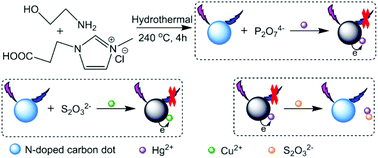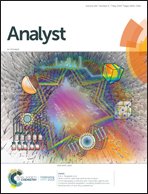Hydrothermal synthesis of N-doped carbon dots from an ethanolamine–ionic liquid gel to construct label-free multifunctional fluorescent probes for Hg2+, Cu2+ and S2O32−†
Abstract
N-Doped carbon dots (NCDs) were facilely synthesized by a hydrothermal method using an ethanolamine–ionic liquid (1-carboxyethyl-3-methyl imidazole chloride) gel as a precursor. The NCDs had an average particle size of 3.4 nm and were partially crystalline and abundant in amide and hydroxyl groups and pyridinic/pyrrolic nitrogen atoms on their surfaces. In water, the NCDs showed excitation- and concentration-dependent photoluminescence (PL) properties with a high salt tolerance and a quantum yield of 24.7% under 350 nm excitation. The PL of the aqueous suspension of NCDs remained stable in a pH range of 4–11 and was significantly quenched by Hg2+ and Cu2+ owing to the strong interactions between the metal ions and the surface groups and/or nitrogen atoms of the NCDs. The possible quenching mechanism was determined to be photo-induced electron transfer. By introducing the masking agents of P2O74− and S2O32− into the aqueous suspension of NCDs, two label-free “turn-off” fluorescent probes for Hg2+ and Cu2+ with a high sensitivity and selectivity were built, respectively. Moreover, the quenched NCDs–Hg2+ system could be used as a selective “turn-on” fluorescent probe for S2O32− due to the strong affinity of S2O32− to Hg2+. The above described three probes all illustrated two good linear detection ranges for Hg2+ (0–10 and 10–50 μM), Cu2+ (0–2.5 and 2.5–40 μM) and S2O32− (0–20 and 20–80 μM), and their limits of detection were calculated to be 0.076, 0.125 and 1.17 μM. The recovery tests demonstrated that the above described probes were reliable and capable of detecting corresponding ions in tap water samples with satisfactory results.



 Please wait while we load your content...
Please wait while we load your content...